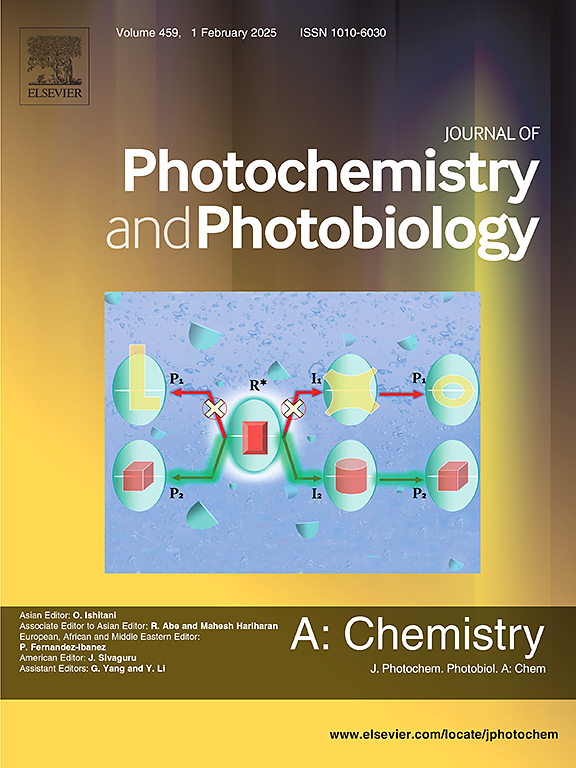Synthesis of bis-organosilane as fluorogenic “turn off” and chromogenic naked eye sensor for Ni(II) and as a potent antioxidant
IF 4.7
3区 化学
Q2 CHEMISTRY, PHYSICAL
Journal of Photochemistry and Photobiology A-chemistry
Pub Date : 2025-06-02
DOI:10.1016/j.jphotochem.2025.116540
引用次数: 0
Abstract
This manuscript illustrates the synthesis of bis-organosilane triazole (4) using click chemistry. The newly synthesized compound was characterized by mass spectrometry and NMR (1H, 13C) spectroscopy. The effectiveness and precision of 4 were verified using UV–visible and fluorescence tests, showing it works very well with Ni(II) without being affected by other metal ions. Both spectroscopic studies show the limit of detection (LOD) values of 268 nM and 41.41 μM, respectively. 4 shows naked-eye sensing, reversibility, and contestability for Ni (II) and effectively imitates the INHIBIT molecular logic gate. Additionally, 4′s catalytic and antioxidant qualities were assessed.

双有机硅烷的合成,作为荧光“关闭”和显色的Ni(II)裸眼传感器和有效的抗氧化剂
本文介绍了用化学反应合成双有机硅烷三唑(4)的方法。用质谱和核磁共振(1H, 13C)谱对新合成的化合物进行了表征。通过紫外可见和荧光测试验证了4的有效性和精度,表明它与Ni(II)非常有效,不受其他金属离子的影响。两种光谱的检测限(LOD)分别为268 nM和41.41 μM。4显示了Ni (II)的裸眼传感、可逆性和可竞争性,并有效地模拟了抑制分子逻辑门。此外,还对4的催化和抗氧化性能进行了评价。
本文章由计算机程序翻译,如有差异,请以英文原文为准。
求助全文
约1分钟内获得全文
求助全文
来源期刊
CiteScore
7.90
自引率
7.00%
发文量
580
审稿时长
48 days
期刊介绍:
JPPA publishes the results of fundamental studies on all aspects of chemical phenomena induced by interactions between light and molecules/matter of all kinds.
All systems capable of being described at the molecular or integrated multimolecular level are appropriate for the journal. This includes all molecular chemical species as well as biomolecular, supramolecular, polymer and other macromolecular systems, as well as solid state photochemistry. In addition, the journal publishes studies of semiconductor and other photoactive organic and inorganic materials, photocatalysis (organic, inorganic, supramolecular and superconductor).
The scope includes condensed and gas phase photochemistry, as well as synchrotron radiation chemistry. A broad range of processes and techniques in photochemistry are covered such as light induced energy, electron and proton transfer; nonlinear photochemical behavior; mechanistic investigation of photochemical reactions and identification of the products of photochemical reactions; quantum yield determinations and measurements of rate constants for primary and secondary photochemical processes; steady-state and time-resolved emission, ultrafast spectroscopic methods, single molecule spectroscopy, time resolved X-ray diffraction, luminescence microscopy, and scattering spectroscopy applied to photochemistry. Papers in emerging and applied areas such as luminescent sensors, electroluminescence, solar energy conversion, atmospheric photochemistry, environmental remediation, and related photocatalytic chemistry are also welcome.

 求助内容:
求助内容: 应助结果提醒方式:
应助结果提醒方式:


